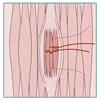News
| ReMoto improved and expanded version. |
| Posted by ReMoto Team in June 26, 2024. |
ReMoto expanded and improved, Fortran version A new and updated version of ReMoto, now in Fortran, is available for download. The new version includes some minor improvements (e.g., now a more uniform distribution of motor units in a skeletal muscle transverse section was attained in comparison with the original version). This version can be found at https://github.com/rnwatanabe/projectFRThe Fortran program was more recently adapted to simulate demyelinating diseases with a focus on studies of force and position tasks exerted by one foot on a pedal (MC de Oliveira, RN Watanabe, AF Kohn, 2022; Journal of Neural Engineering, https://iopscience.iop.org/article/10.1088/1741-2552/ac91f8). This newer version can be found at https://github.com/oliveiramarina/ReMoto_AIDP. The adapted version includes some features/corrections that were not included in the first Fortran version, that are:
|
